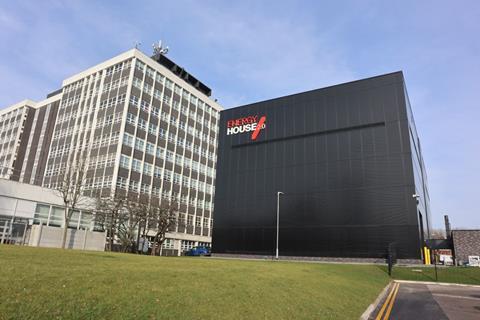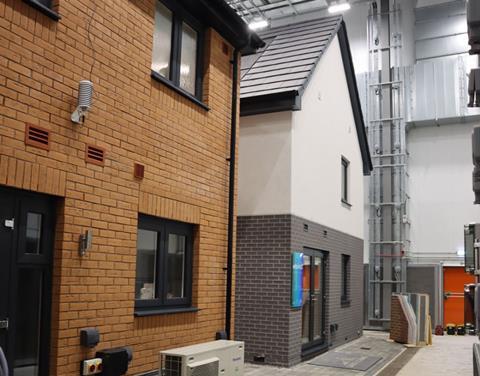The University of Salford says its Energy House 2.0 can simulate 95% of the world’s environmental conditions. Daniel Gayne visits the homes of the future that are being devised to meet the challenges of climate change


It is just past noon in Salford, but the temperature has dropped below 0°C and there is snow on the ground. Even for the frigid North-west of England, these are unseasonal conditions for a fair day in mid-February.
No, this is not the set of a Mancunian remake of The Day After Tomorrow, but rather a £16m university research facility which will test the homes of the future against the elements. The snow is here because Chinese broadcast media were on site yesterday and wanted something visual to shoot.
Mike Brown, director of strategic partnerships at the University of Salford, tells me that synthesising such conditions is the bread and butter of Energy House 2.0. Completed just weeks ago, the facility is the largest, among very few, of its kind in the world.
Two full-size three-bedroom detached houses have been built inside chamber 1 and will, over the next nine months, undergo rigorous whole-building testing including thermal performance, energy efficiency, running costs and comfort, as well as their ability to cope with extreme climates. “We believe this is globally unique,” says Brown, adding that the only similar facility he is aware of is in the United States, run by the Department of Defense.
>> Find out more about the Building the Future Commission
Typically, if housebuilders want to run the numbers on the performance of a new model, they just have to build it on a plot somewhere and see how it handles whatever the seasons happen to throw at it for the next two or three years. This, Brown points out, is not only time-consuming, but pretty unreliable.
“You can’t guarantee what weather you are going to get from one year to the next – or even from one day to the next,” he says. By contrast, in Energy House 2.0, researchers can precisely control the environment to within half a degree, meaning they can gather the same data in just a few weeks using its two research chambers, which are housed within a super-insulated steel frame and plumbed with a combined £5m-worth of heating, ventilation and air conditioning equipment.
The 6,000m2 facility can synthesise rain, snow, gale-force wind and the movement of the sun using movable jigs and produce temperatures ranging from –20°C to +40°C. Perhaps most impressively, it is a dynamic thermal environment, meaning that if heat is released from within one of the test homes (say, by a window or door being opened), the overall external temperature will remain constant.

Arguably even more impressive than that is the fact that its debut research project involves two large, competitor housebuilders collaborating together, so far without incident. On one side of chamber 1 lies the eHome2 by Barratt Developments and products firm Saint Gobain and, on the other, is Bellway’s Future Home. Besides their setting within an enormous metal box, both houses look like fairly conventional family homes from the outside. But this belies the boundary-pushing technical elements hidden beneath, as well as the significantly different approaches taken by the two housebuilders.
Tom Cox, technical and development director at Saint Gobain Offsite Solutions, describes the rationale behind the eHome2 as “almost like a concept car-based approach”, trying to develop the most boundary-pushing product possible and then figuring out which elements can be practically brought to the market.
“That approach gave us the base to really push the boundaries that we can’t do on an active site that is mortgageable at the end of the build,” he said.
I think there is a big end-user education piece because these aren’t going to be as simple as you throw a shell up, stick in a combi boiler and you’ve got some light switches
Tom Cox, technical and development director at Saint Gobain Offsite Solutions
In its structure, the Barratt/Saint Gobain house uses a combination of off-site modern methods of construction, with Saint Gobain Offsite Solutions supplying timber frame products and factory-installed pre-insulated walls to achieve 61% pre-manufactured value.
The building’s Posi-Joist floor cassettes, pre-fabricated by Pasquill, feature a metal webbed design which creates a larger service void that can accommodate the greater amount of heating, ventilation and energy services needed to exceed the Future Home Standards requirements. Into these cassettes is installed a 36cm-thick panelised solution from Scotframe, comprised of high-efficiency mineral wool fitted between an i-stud timber frame and clad with a thin mock-brick finish.
Saint Gobain Offsite Solutions claims the house can be erected from the slab to the finished roof, including cladding and windows, in just two weeks. According to the firm, a traditionally built house would need 55cm-thick walls to meet the EPC A-rating achieved by eHome2.

Inside, the skirting boards act as a dispersed heat source from the air source heat pump, while infrared panels provide additional localised heat sources. The house is packed with smart technology, all run through a building management system called Loxone.
The system has all kind of automations built in – one feature tracks the course of the sun and adjusts the blinds to prevent internal overheating, while a speaker in the bathroom reminds occupants to take their medication at a particular time – and the whole thing is run through a single app.
The system is undoubtedly impressive and, according to Cox, will become increasingly necessary to operate the quantity of mechanical and electrical equipment that will soon be standard in homes. But, looking at the complex units the house has installed in lieu of traditional light switches, it is difficult not to see this as a stumbling block for the introduction of these “future homes” to the broader market.
House buyers can be stubbornly conservative and many – particularly older buyers – may not be especially interested in buying a home they have to learn how to use. “I think there is a big end-user education piece because these aren’t going to be as simple as you throw a shell up, stick in a combi boiler and you’ve got some light switches,” admits Cox, although he adds that their single system and “simple interface” is a good “starting point” for that effort.
He says the mechanical, electrical and plumbing (MEP) in the homes of the future will perform to the level typical of commercial buildings and suggests that we may need to expect levels of maintenance and management to match. “It’s not beyond the wit to look at almost a sort of monthly subscription – so you have people who look after your house,” he says.
The original Energy House
Before Energy House 2.0, there was the Energy House. Twelve years ago, scientists at the University of Salford rebuilt an entire redbrick terraced house inside a sealed testing chamber to study energy use and retrofit measures in dwellings that represent 5% of the UK’s housing stock.
The two-up, two-down homes are almost identical to those depicted in Coronation Street and were also put to the test in simulated climates (though not to the degree of precision made possibe by the new facility).
According to Mike Brown, the second Energy House project was “dreamed up” by the team behind the Victorian terrace and has been delivered because of funding from the university and the Office for Students, as well as the England European Regional Development Fund, which pitched in with £8.4m
By contrast with the “concept car” approach, Bellway has designed a more traditional brick home based on its Coppersmith model and then sought to work out where it can push the envelope on energy efficiency. “This research project in an environmental chamber, to me it’s about space and water heating and ventilation, rather than anything else,” says Jamie Bursnell, technical and innovation manager at Bellway, explaining the slightly less ambitious scope of their project.
Bursnell says the purpose of the Future Home is not to test the boundaries of possibility, but to find “the optimum configuration of fabric, space heating, emitters, controllers, delivery of domestic hot water, ventilation and efficient services”, while “putting the customer first”. The Future Home will test underfloor, infrared and ambient heating, mechanical ventilation and enhanced insulation, all using energy efficiency products already out on the market.
The waste-water treatment recovery shower tray employed in the bathroom is the only prototype product in the entire house. One interesting feature of the home is its roof-mounted air source heat pump, the first of its kind in the UK, although Bursnell admits that this is as much a product of statistics as of innovative thinking – “there are so few going into new-build [in the UK], how many are going into the roof?”.
Learnings here will become common design principles in Bellway design types going forward
Jamie Bursnell, technical and innovation manager at Bellway
While Bellway’s standard Coppersmith house achieves an EPC rating of B, with running costs of £761 a year for heating, hot water, lighting, pumps and fans, the Future Home gets an A rating, and its solar panels bring annual operating costs down to just £11. The research team is planning a half-term upgrade to the property, improving the u-value of the walls and moving from double to triple glazing.
“That way, we can actually assess the impact of the extra capex in fabric against what its actual contribution is,” says Bursnell.
Bellway’s research project is a firmly pragmatic one in his eyes – helping the company to work out how it can take the consumer on that tricky journey towards accepting a new kind of home. “We have got to understand ourselves to educate our customers to live with slow cycle heating,” he says, noting that monoblock air source heat pumps, wastewater heat recovery systems and triple glazing are all likely to be implemented in Bellway’s homes in the coming years.
“Learnings here will become common design principles in Bellway design types going forward,” he adds.
The housebuilders and the university will ultimately publish the results of the research project as a consortium, with the findings to be made available to the whole industry. An independent post-doctorate level graduate will oversee nine months of testing and will then spend another next nine months writing up the report.
Testing begins in March but, before that, Bursnell and Cox will get a taste of life in the Energy House, spending an evening as residents in the homes to experience using them first-hand. Cox says having actual people staying inside the houses will be a very valuable part of the research, helping them to understand some of the gaps between results from software used to model energy performance and in-situ performance.
“The thing is, designing a house and bringing it to this stage is easy,” he says. “The awkward thing is putting those bloody awkward things – humans – in it. Because no matter how you model a house, the people who live in it will never use it as you expect.”
For Salford University, the prospects for Energy House 2.0 extend far beyond the current project. There is a whole second chamber that is yet to be put to use and the powerful capacities of the facility make it suitable for a much broader range of research programmes.
Brown claims that environmental conditions experienced by 95% of the world’s population can be replicated, giving the university an added global attraction. The facility will also be able to help build resilience for a changing climate.
“We can test housing for predicted climate change events. We can test for today’s climate, 10 years in the future climate, 20 years in the future climate,” says Brown.

Expert view: Marguerita Chorafa on holistic thinking required to adapt homes to a changing climate
You only have to think back to the soaring temperatures we saw last year to get a sense of the extreme weather our homes are now being exposed to. Building in resilience to designs is vital to making sure properties remain comfortable to live in, as well as greener and cheaper to run.
Thinking holistically is so important to getting this right. Too often the conversation can get stuck on energy efficiency in the winter, but how do different design elements improve cooling in the summer?
There are material solutions and systems available, but they can be overlooked as seemingly too expensive or just because people are less familiar with them.

External shading (retractable or fixed) for example can maximise efficiency in both the winter and summer months by adapting to differing temperatures and the position of the sun. As an industry, we need to get past the temptation to keep doing things as we have always done and encourage consumers to be more open to different approaches as well. Hopefully these kinds of research initiatives will push us to explore new technologies and make smarter design choices.
Marguerita Chorafa is associate environmental designer and analyst at Introba UK. She works on Introba’s sustainability team with Building the Future commissioner Clara Bagenal George, an associate at Introba and mayor of London design advocate for good growth.
Building the Future Commission

Coming up on the Building the Future commission:
In the coming weeks we will:
- Host our first regional roundtable with our partner Constructing Excellence in the East of England region in mid March
- Convene our first commissioner panel meeting at the end of March
- Interview two big hitters in the world of infrastructure for the infrastructure stream
- Examine whether the qualifications landscape needs to change and assess whether more flexibility is needed for our education and skills stream
- Investigate how for-profit affordable housing can deliver the homes we need for the housing and planning stream
- Assess a new model of procurement used by the Ministry of Defence for the project delivery and digital stream
- Look at models of flexible working in the industry for the workplace, culture and leadership stream
About the commission
The Building the Future Commission is a year-long project, launched to mark Building’s 180th anniversary, to assess potential solutions and radical new ways of thinking to improve the built environment.
The major project’s work will be guided by a panel of 19 major figures who have signed up to help guide the commission’s work culminatuing culminate in a report published at the end of the year.
The commissioner include figures from the world of contracting, housing development, architecture, policy-making, skills, design, place-making, infrastructure, consultancy and legal.
The commissioners include Lord Kerslake, former head of the civil service, Katy Dowding, executive vice president at Skanska, Richard Steer, chair of Gleeds, Lara Oyedele, president of the Chartered Institute of Housing, Mark Wild, former boss of Crossrail and chief executive of SGN and Simon Tolson, senior partner at Fenwick Elliott. See the full list here.
The project is looking at proposals for change in eight areas:
- Education and skills
- Housing and planning
- Infrastructure
- Building safety
- Project delivery and digital
- Workplace culture and leadership
- Creating communities
>> Editor’s view: And now for something completely positive - our Building the Future Commission
>> Click here for more about the project and the commissioners
Building the Future will also undertake a countrywide tour of roundtable discussions with experts around the regions as part of a consultation programme in partnership with the regional arms of industry body Constructing Excellence. It will also set up a young person’s advisory panel.
We will also be setting up an ideas hub and we want to hear your views.




























No comments yet